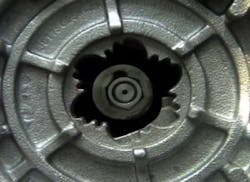Ford-Gelatt, in Baton Rouge, Louisiana, provides industrial pumping equipment to the oil and gas, power generation, and chemical process industries. They’ve supported the second largest chemical manufacturer in the United States with sourcing and selecting pumps for a variety of applications for more than two decades.
When the chemical manufacturer experienced frequent clogging of their pumps, they contacted Scott Swilley, Industrial Equipment Specialist at Ford-Gelatt, to find a solution to avoid flooding and clean-up costs.
The Challenge
The manufacturer was using two horizontal self-priming pumps for two 9-foot deep sewage sumps. The pumps send raw sewage from their building to the nearby wastewater treatment facility. These pumps clogged excessively leading to flooding on two separate occasions, forcing employees out of the facility into off-site rental trailers. The clean-up was costly as they had to bring in a third-party company to clean and sanitize the flooded area.
Not wanting to risk a third raw sewage flood, the facility’s maintenance manager contacted Swilley to replace the self-priming pumps. It was clear the new corrosion resistant pumps would need to meet the following requirements:
- Non-Clog. It was critical to select corrosion resistant pumps that could handle solids and raw sewage entering the sumps. The new pumps needed to reliably transport the raw sewage out of the sumps to the effluent treatment facility.
- Rated for Continuous Duty. The pumps required to be operated almost 24-hours a day, 7 days a week, so it was necessary for them to run for extended periods of time.
- Durable and Reliable. Given the solids and chemicals in the liquid, the pumps would need to be durable and reliable enough to stand up to the application.
The Solution
The chemical manufacturer was already using six BJM Pumps stainless-steel submersible shredder pumps (BJM SKX Series) in other parts of their facility. Due to his experience with their performance, the maintenance manager was confident in the SKX Series pumps.
For these specific sewage lift sumps, Swilley recommended, the SKX110CSS, as it met the criteria above, including:
- Tungsten Carbide Tip Impellers cut and pass solids up to 3.5 inches in size. This specially engineered impeller cuts against a spiral-shaped diffuser plate to rip solids apart with 360-degree shredding action.
- All internal components exposed to the raw sewage are made of corrosion resistant 316 Stainless Steel, including the impeller, wear-plate, seal chamber, and pump volute. With its durable construction, this pump rates for continuous duty and is built to last.
- “Three Seal Motor Protection” includes an oil-lubricated double seal design that protects the motor. An additional lip seal above the impeller prevents abrasives from entering into the seal chamber.
The Result
The chemical manufacturer purchased two SKX110CSS pumps. Since the installation in the sewage application, the pumps continue to work well with no clogging and flooding. The chemical manufacturer plans to purchase two additional SKX pumps for their other two sewage lift sumps. Industrial Flow Solutions provided the guide rails to make installation and future maintenance easier.
Editor's Note: Scranton Gillette Communications and the SGC Water Group are not liable for the accuracy, efficacy and validity of the claims made in this piece. The views expressed in this content do not reflect the position of the editorial teams of Water & Wastes Digest, Water Quality Products and Storm Water Solutions.

